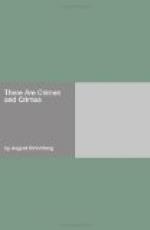But in the title which bound it to “Advent” at their joint publication we have a better clue to what the author himself undoubtedly regards as the most important element of his work—its religious tendency. The “higher court,” in which are tried the crimes of Maurice, Adolphe, and Henriette, is, of course, the highest one that man can imagine. And the crimes of which they have all become guilty are those which, as Adolphe remarks, “are not mentioned in the criminal code”—in a word, crimes against the spirit, against the impalpable power that moves us, against God. The play, seen in this light, pictures a deep-reaching spiritual change, leading us step by step from the soul adrift on the waters of life to the state where it is definitely oriented and impelled.
There are two distinct currents discernible in this dramatic revelation of progress from spiritual chaos to spiritual order— for to order the play must be said to lead, and progress is implied in its onward movement, if there be anything at all in our growing modern conviction that any vital faith is better than none at all. One of the currents in question refers to the means rather than the end, to the road rather than the goal. It brings us back to those uncanny soul-adventures by which Strindberg himself won his way to the “full, rock-firm Certitude” of which the play in its entirety is the first tangible expression. The elements entering into this current are not only mystical, but occult. They are derived in part from Swedenborg, and in part from that picturesque French dreamer who signs himself “Sar Peladan”; but mostly they have sprung out of Strindberg’s own experiences in moments of abnormal tension.
What happened, or seemed to happen, to himself at Paris in 1895, and what he later described with such bewildering exactitude in his “Inferno” and “Legends,” all this is here presented in dramatic form, but a little toned down, both to suit the needs of the stage and the calmer mood of the author. Coincidence is law. It is the finger-point of Providence, the signal to man that he must beware. Mystery is the gospel: the secret knitting of man to man, of fact to fact, deep beneath the surface of visible and audible existence. Few writers could take us into such a realm of probable impossibilities and possible improbabilities without losing all claim to serious consideration. If Strindberg has thus ventured to our gain and no loss of his own, his success can be explained only by the presence in the play of that second, parallel current of thought and feeling.
This deeper current is as simple as the one nearer the surface is fantastic. It is the manifestation of that “rock-firm Certitude” to which I have already referred. And nothing will bring us nearer to it than Strindberg’s own confession of faith, given in his “Speeches to the Swedish Nation” two years ago. In that pamphlet there is a chapter headed “Religion,” in which occurs this passage: “Since 1896




